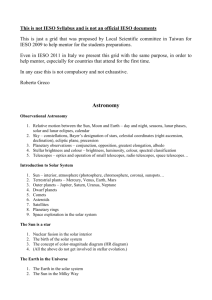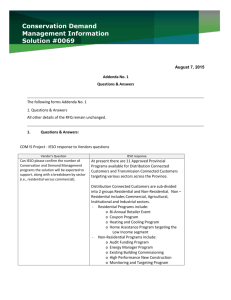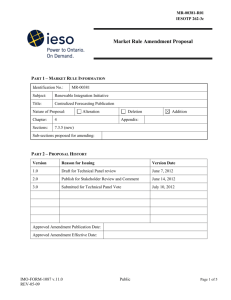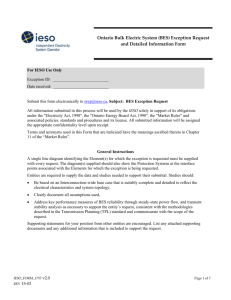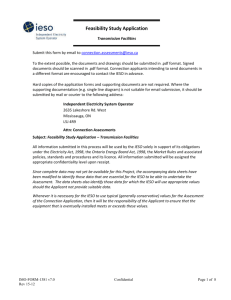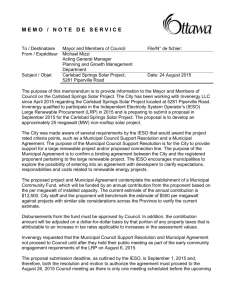Market Rule Amendment Proposal
advertisement
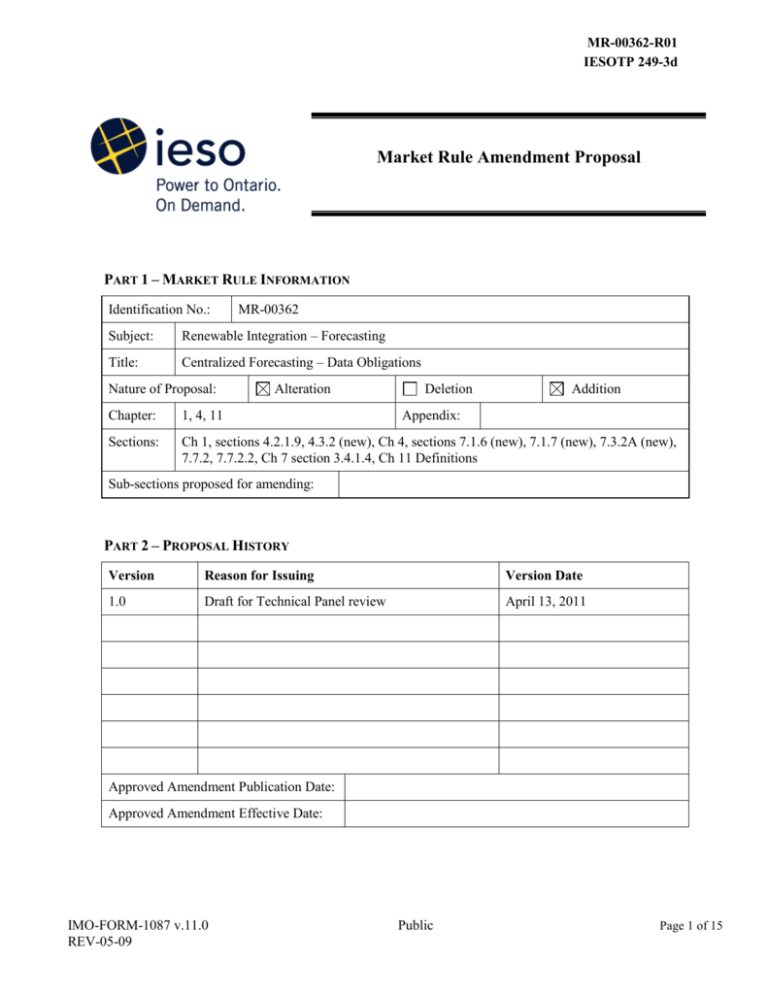
MR-00362-R01 IESOTP 249-3d Market Rule Amendment Proposal PART 1 – MARKET RULE INFORMATION Identification No.: MR-00362 Subject: Renewable Integration – Forecasting Title: Centralized Forecasting – Data Obligations Nature of Proposal: Alteration Deletion Addition Chapter: 1, 4, 11 Appendix: Sections: Ch 1, sections 4.2.1.9, 4.3.2 (new), Ch 4, sections 7.1.6 (new), 7.1.7 (new), 7.3.2A (new), 7.7.2, 7.7.2.2, Ch 7 section 3.4.1.4, Ch 11 Definitions Sub-sections proposed for amending: PART 2 – PROPOSAL HISTORY Version Reason for Issuing Version Date 1.0 Draft for Technical Panel review April 13, 2011 Approved Amendment Publication Date: Approved Amendment Effective Date: IMO-FORM-1087 v.11.0 REV-05-09 Public Page 1 of 15 MR-00362-R01 IESOTP 249-3d PART 3 – EXPLANATION FOR PROPOSED AMENDMENT Provide a brief description of the following: The reason for the proposed amendment and the impact on the IESO-administered markets if the amendment is not made. Alternative solutions considered. The proposed amendment, how the amendment addresses the above reason and impact of the proposed amendment on the IESO-administered markets. Summary It is proposed to amend the market rules to: (i) reflect the IESO’s authority under the Electricity Act, 1998 to create market rules applicable to generators which are connected to a distribution system, (“embedded generators”); (ii) obligate variable generators to submit static and dynamic data for purposes of centralized forecasting; (iii) specify the performance standards for the communication of data to the IESO for variable generators that have no existing requirements to communicate with the IESO. This proposal is based on the “SE-91 Renewable Integration Final Design Principles” – Principles 1, 4 and 5” as part of SE-91 Renewable Integration1. The attached Appendices A and B summarize the proposed static and dynamic data requirements for wind and solar generators as discussed and agreed with the Visibility Technical Working Group (VTWG)2. Background Centralized forecasting will replace the existing decentralized forecasting approach and as a result, market participants with variable generation will no longer be required to submit energy forecasts for their facilities. Instead, those market participants will be responsible for providing site specific data that will be used as inputs to variable generation forecasts generated by a third party service provider. Discussion Chapters 1, 11 Through the Green Energy Act (Bill 150), amendments to the Electricity Act, 1998 give the IESO the explicit authority to create and enforce market rules related to reliability, including market rules 1 SE-91 Renewable Integration Final Design Principles: http://www.ieso.ca/imoweb/pubs/consult/se91/se9120110309-Final_Design_Principles.pdf 2 For further information and materials on VTWG, please refer to: Renewable Integration (SE-91) - Visibility Technical Working Group Page 2 of 15 Public IMO-FORM-1087 v.11.0 REV-05-09 MR-00362-R01 IESOTP 249-3d PART 3 – EXPLANATION FOR PROPOSED AMENDMENT relating to electricity supplied by generators connected to a distribution system.3 Embedded generators selling electricity through a distributor (i.e. settling for amounts through a distributor's retail settlement system for energy injected into the distribution system) are also required to have an OEB license, which obligates the licensee to comply with all applicable market rules.4 Consistent with the IESO’s authority under the Electricity Act, 1998 to create and enforce market rules relating to embedded generators, it is proposed to add section 4.3.1 (new) of Chapter 1 to specify that the market rules have the effect of a contract between the IESO and any person providing electricity supply generated from sources connected to a distribution system. This change ensures that the applicable market rules apply to embedded generators whether they are market participants or not. By specifying that applicable market rules apply to persons that are not market participants, consequential amendments are required in sections 4.2.1.9 of Chapter 1 and Chapter 11. These changes include: Specifying that the mechanisms for monitoring, surveillance and investigation of activities in the IESO-administered market also apply (Ch 1, sec 4.2.1.9). Amending the definition of “applicable law” to reflect the IESO’s market rule authority with respect to embedded generators that are not market participants. Chapters 4, 7 – Static and Dynamic Data Obligations Under a centralized forecasting service, wind and solar generators with an installed capacity of 5MW or greater (i.e. market participants or embedded non-market participants), as well as wind and solar generators directly connected to the IESO-controlled grid (i.e. market participants) will be responsible for collecting and submitting site specific data and relaying that data to the IESO. Once the centralized forecasting service is implemented within the IESO’s operations, wind and solar generators currently subject to decentralized forecasting will no longer be required to submit their own energy forecasts to the IESO. During the transition period between decentralized and centralized forecasting, wind and solar resources will be required to submit site specific data as well as their own forecasts for an interim period. It is proposed to amend the market rules in chapter 4, sections 7.1.6 (new), 7.1.7 (new), and chapter 7, section 3.4.1.4: 3 Ch 4, 7.1.6 obligates variable generators (wind and solar) to provide the static and dynamic Electricity Act, section 32(1)(c) Electricity Act, 1998, S.O. 1998, c. 15, Sched. A 4 Electricity Generator Sample License, sections 4.1 and 4.2: http://www.ontarioenergyboard.ca/OEB/_Documents/Licences/FIT_Generator_SAMPLE_application.pdf FIT Generator Sample License, section s 4.1 and 4.2: http://www.ontarioenergyboard.ca/OEB/_Documents/Licences/licence_EG_template_2008.pdf IMO-FORM-1087 v.11.0 REV-05-09 Public Page 3 of 15 MR-00362-R01 IESOTP 249-3d PART 3 – EXPLANATION FOR PROPOSED AMENDMENT data in accordance with the applicable market manual (see Appendix A and B). Ch 4, section 7.1.7 obligates wind and solar generators that are authorized market participants (i.e. are intermittent as well as variable generators) to continue to submit their own forecasts during the transition period between decentralized and centralized forecasting. The requirement to submit their own forecasts will cease on the implementation date of centralized forecasting. Ch 7, section 3.4.1.4 specifies that an intermittent generator that is a variable generator will no longer be required to submit their own forecasts on the implementation date of centralized forecasting. Chapter 4 – Communication Requirements All variable generators (wind and solar) subject to centralized forecasting will have a requirement to communicate with the IESO. Existing or new market participants will continue to be bound by the existing communication requirements in section 7 of chapter 4 and appendix 4. It is proposed that embedded variable generators (wind and solar) that are not market participants but 5MW or greater be classified as “medium” performance facilities per Appendix 4.19, for which the dynamic data in Appendix A and B must be provided to the IESO. It is proposed to amend the market rules in chapter 4, sections 7.3.2A (new), and 7.7.2, and 7.7.2.2: Section 7.3.2A specifies variable generators that do not have communication requirements as per the existing market rules will be required to meet at a minimum, the medium performance standards in Appendix 4.19 for sending the required dynamic data to the IESO. Acceptable monitoring and control devices will be specified in the applicable market manual. Section 7.7.2 adds variable generators that are not market participants and do not have communication requirements per the existing market rules to the medium performance standard maintenance and repair requirements for monitoring and control equipment (i.e. response no later than the next day following the day on which the equipment outage or defect is discovered). PART 4 – PROPOSED AMENDMENT Chapter 1 4.2 Purposes of Market Rules 4.2.1 Accordingly, the market rules include provisions: 4.2.1.1 Page 4 of 15 governing the making, amendment and publication of the market rules; Public IMO-FORM-1087 v.11.0 REV-05-09 MR-00362-R01 IESOTP 249-3d 4.2.1.2 governing the conveying of electricity into, through or out of the IESO-controlled grid and the provision of ancillary services; 4.2.1.3 governing the terms and conditions pursuant to which persons may be authorized by the IESO to participate in the IESO-administered markets or to cause or permit electricity to be conveyed into, through or out of the IESO-controlled grid; 4.2.1.4 governing the manner in which electricity and ancillary services are sold, purchased and dispatched in the IESO-administered markets; 4.2.1.5 governing standards and procedures to be observed in system emergencies; 4.2.1.6 authorizing and governing the giving of directions by the IESO; 4.2.1.7 authorizing and governing the making of orders by the IESO; 4.2.1.8 providing a mechanism for the resolution of certain disputes arising under the market rules; 4.2.1.9 providing mechanisms for monitoring, surveillance and investigation of activities in the IESO-administered markets and the conduct of market participants or persons providing electricity supply generated from sources connected to a distribution system; and 4.2.1.10 providing generally for the exercise by the IESO of such powers and authority as may be necessary or desirable for the purpose of carrying out its objects in relation to the IESO-administered markets and the IESO-controlled grid. 4.3 Contractual Force 4.3.1 The market rules have the effect of a contract between each market participant and the IESO by virtue of the execution by the IESO and each market participant of the participation agreement under which each market participant and the IESO agree to perform and observe the market rules so far as they are applicable to each market participant and the IESO as provided for in the market rules, their respective licences and applicable law. 4.3.2 The market rules have the effect of a contract between each person providing electricity supply generated from sources connected to a distribution system under which each such person and the IESO agree to perform and observe the market rules so far as they are applicable to each such person and the IESO as provided for in the market rules, their respective licences and applicable law. IMO-FORM-1087 v.11.0 REV-05-09 Public Page 5 of 15 MR-00362-R01 IESOTP 249-3d ……………….. Chapter 4 7. Provision of Connection-Related Information 7.1 Provision of Information 7.1.1 [Intentionally left blank] 7.1.2 A market participant that becomes aware of any material change to or inconsistency with any information or data previously supplied to another market participant or to the IESO in accordance with a new or modified connection that could affect the reliability of the IESO-controlled grid shall promptly notify the IESO and such other market participant in writing of that change or inconsistency. 7.1.3 Each generator whose generation facility is connected to the IESO-controlled grid, connected wholesale customer and distributor connected to the IESOcontrolled grid, and transmitter shall provide to the IESO the information described in Appendices 4.5A to 4.9, as applicable prior to placing any connected facility into service. 7.1.4 Each embedded generator whose embedded generation facility includes a generation unit rated at greater than 10 MVA and that is designated by the IESO for the purposes of this section 7.1 shall provide to the IESO the information described in Part A of Appendix 4.6 as may be requested by the IESO. 7.1.5 Each embedded generator that: 7.1.5.1 participates in the IESO-administered markets and whose embedded generation facility includes a generation unit rated at 1 MW or higher; 7.1.5.2 is a non-market participant and whose embedded generation facility includes a generation unit rated at 10 MVA or higher, and that is not required to provide data pursuant to section 7.1.4, shall provide the IESO with the data listed in Part B of Appendix 4.6. 7.1.6 Each variable generator shall provide data to the IESO in accordance with the applicable market manual for the purposes of deriving forecasts of the amount of energy that the variable generator is capable of producing. 7.1.7 Each variable generator that is a market participant shall submit dispatch data in such form as may be specified by the IESO indicating its best forecast of the Page 6 of 15 Public IMO-FORM-1087 v.11.0 REV-05-09 MR-00362-R01 IESOTP 249-3d amount of energy that the variable generator can inject in each dispatch hour. This section shall cease to have effect on a date to be determined by the IESO with such date to be published by the IESO. ……………….. 7.3 Monitoring Information Provided by Generators to the IESO 7.3.1 Subject to section 7.3.2, in order to permit the IESO to direct the operations of the IESO-controlled grid, each: 7.3.1.1 generator (i) whose generation facility is connected to the IESOcontrolled grid, or (ii) that is participating in the IESO-administered markets; and 7.3.1.2 embedded generator (i) that is not a market participant or whose embedded generation facility is not a registered facility; (ii) whose embedded generation facility includes a generation unit rated at greater than 20 MVA or that comprises generation units the ratings of which in the aggregate exceeds 20 MVA; and (iii) that is designated by the IESO for the purposes of this section 7.3.1 as being required to provide such data in order to enable the IESO to maintain the reliability of the IESO-controlled grid, shall provide the IESO with the data listed in Appendix 4.15 on a continual basis. Such data shall not be modified by the generator and shall be provided: 7.3.2 7.3.1.3 with equipment that meets the requirements set forth in Appendix 2.2 of Chapter 2; and 7.3.1.4 subject to section 7.6A, in accordance with the performance standards set forth in Appendix 4.19. Section 7.3.1 does not apply to: 7.3.2.1 a small generation facility; 7.3.2.2 a self-scheduling generation facility that has a name-plate rating of less than 10 MW; or 7.3.2.3 an intermittent generator or a transitional scheduling generator that is comprised solely of a generation unit rated at less than 20 MW or of generation units the ratings of which in the aggregate is less than 20 IMO-FORM-1087 v.11.0 REV-05-09 Public Page 7 of 15 MR-00362-R01 IESOTP 249-3d MW unless designated by the IESO at the time of registration as affecting the reliability of the IESO-controlled grid. 7.3.2A Each variable generator not otherwise subject to any communication requirements specified in this chapter shall at a minimum, meet the medium performance standards set forth in Appendix 4.19 for the purposes of providing data in accordance with section 7.1.6. ……………….. 7.7 Reliability, Maintenance and Repair of Monitoring and Control Equipment 7.7.1 Each person referred to in section 7.3.1, 7.4.1, 7.5.1, 7.5.2 or 7.6.1, as the case may be, shall maintain the monitoring and control equipment referred to in Appendices 4.15 to 4.18 as applicable, in accordance with good utility practice and shall ensure that such equipment: 7.7.1.1 has an overall mean time between failures of: a. no less than three years; or b. no less than five years, if the equipment is designated by the IESO as significant for purposes of enabling the IESO to maintain the reliability of the IESO-controlled grid; 7.7.1.1A each person referred to in section 7.7.1 shall report and schedule with the IESO all planned changes to monitoring equipment referred to in section 7.7.1.1 and associated potential and current transformers and other devices affecting the accuracy or the reliability of such equipment; 7.7.1.2 7.7.2 is secure from the effects of interruptions in power supply for a period of at least eight hours. Each person referred to in section 7.7.1 and 7.3.2A shall respond to an outage of or defect in the equipment referred to in section 7.7.1 or the applicable market manual: 7.7.2.1 immediately, in the case of equipment relating to facilities to which the high performance information monitoring standard applies pursuant to Appendices 4.19 to 4.23 other than significant generation facilities and significant dispatchable load facilities; a. [Intentionally left blank] b. [Intentionally left blank] Page 8 of 15 Public IMO-FORM-1087 v.11.0 REV-05-09 MR-00362-R01 IESOTP 249-3d c. [Intentionally left blank] d. [Intentionally left blank] e. [Intentionally left blank] f. [Intentionally left blank] g. [Intentionally left blank] h. [Intentionally left blank] 7.7.2.2 no later than the next day following the day on which the outage or defect is discovered, in the case of equipment relating to significant generation facilities, significant dispatchable load facilities, variable generation, and facilities to which the medium performance information monitoring standard applies pursuant to Appendices 4.19 to 4.23. a. [Intentionally left blank] b. [Intentionally left blank] c. [Intentionally left blank] d. [Intentionally left blank] e. [Intentionally left blank] f. [Intentionally left blank] Chapter 7 3.4 The Form of Dispatch Data 3.4.1 Dispatch data shall relate to a specified dispatch hour of the dispatch day and to a specified registered facility, shall comply with the applicable provisions of this section and sections 3.5 to 3.9 and shall take one of the following forms: ……………….. 3.4.1.4 IMO-FORM-1087 v.11.0 REV-05-09 for an intermittent generator, a forecast of energy expected to be provided to the energy market. Energy actually provided by an intermittent generator results in sales in the real-time market only to the extent that, for the registered market participant designated for such intermittent generator, the total value of energy provided to the real-time market is greater than the total value of physical bilateral contract quantities notified to the IESO by that registered market Public Page 9 of 15 MR-00362-R01 IESOTP 249-3d participant pursuant to Chapter 8. For an intermittent generator that is a variable generator, this section shall cease to have effect on a date to be determined by the IESO with such date to be published by the IESO; .................... Chapter 11 1. Definitions [Note: the proposed definition for “variable generation” below is included for reference only; it is proposed under MR-00362-R00: Centralized Forecasting – Cost Recovery.] variable generation means all wind, solar, and other variable resources as specified by the IESO with an installed capacity of 5MW or greater and all wind, solar, and other variable resources as specified by the IESO that are directly connected to the IESO-controlled grid; applicable law means all laws, regulations, other statutory instruments and rules and other documents of a legislative nature which apply to the IESO or to market participants or persons providing electricity supply generated from sources connected to a distribution system, and all orders of a government, governmental body, authority or agency having jurisdiction over the IESO or a market participant or person providing electricity supply generated from sources connected to a distribution system including, but not limited to, any licence issued to the IESO or a market participant or person providing electricity supply generated from sources connected to a distribution system; PART 5 – IESO BOARD DECISION RATIONALE Insert Text Here Page 10 of 15 Public IMO-FORM-1087 v.11.0 REV-05-09 MR-00362-R01 IESOTP 249-3d Appendix A – Wind Generator Data Requirements 1. Static Data The following table proposes static plant data requirements for the physical layout of the facility and details of the turbines that would be required at the time of a connection assessment/registration application. # 1 Static Plant Information Turbine Hub location 2 Meteorological (MET) Tower location 3 Type of turbine 4 Manufacturer’s power curve 5 Cut in speed 6 Cut out speed 7 Cut out temperature Description Turbine Hub location (latitude and longitude), height, and elevation from sea level. Physical location (latitude and longitude), height, and elevation from sea level. Whether the turbine is a horizontal or vertical axis type. Power curve maps containing expected output for a turbine at varying wind speeds. The lowest wind speed (metres per second [m/s]) at which the turbine will generate power. The wind speed (m/s) at which the wind turbine will be shut down to prevent physical damage. The maximum and minimum ambient temperature (in °C) at which the wind turbine will be shut down to prevent physical damage. 2. Dynamic Data The following table proposes dynamic plant data requirements for what would be required at the time of a connection assessment/registration application. # Measurement Type Unit of Measure Metres per Second (m/s) Height of Measurement Hub height Precision (to the nearest…) 0.1 m/s 1 Wind Speed 2 Wind Direction Degrees from True North Hub height 1 degree 3 Ambient Air Tempurature 4 Barometric Pressure Degrees Celsius (°C) Hub height or 2m 0.1 °C Hectopascals (HPa) Hub height or 2m 60 Pa 5 Relative Humidity Percentage (%) Hub height or 2m 1.0% 6 MW output5 (per facility) Megawatt (MW) N/A 0.1 MW 5 Megawatts shall be provided per existing generator requirements specified in the market rules and market manuals. IMO-FORM-1087 v.11.0 REV-05-09 Public Page 11 of 15 MR-00362-R01 IESOTP 249-3d # Measurement Type Unit of Measure 7 Available Megawatts6 Megawatt (MW) Height of Measurement N/A Precision (to the nearest…) 0.1 MW Note: Planned outages and derates shall be reported per existing reporting requirements. Dynamic Data Collection The IESO proposes that dynamic data elements numbered 1 through 5 inclusive in the above table be collected such that no turbine is further than 5km from the nearest nacelle mounted meteorological data collection point. This is the minimum requirement only and facilities are encouraged to collect and send this data from as many points at the facility as are available. Each wind facility shall provide dynamic data elements numbered 1 through 5 inclusive in the above table from standalone meteorological towers that are located in areas that are representative of the microclimate and winds at hub height on the prevailing upstream side of the wind farm. Wind facilities shall provide data from multiple meteorological towers per the following table. Facility Size Less than 10MW 10MW to less than 100MW 100MW to less than 200MW 200MW to less than 300MW Etc. Total number of meteorological towers per facility None 1 minimum 2 minimum 3 minimum Dynamic data elements numbered 1 through 5 shall be reported to the IESO at least once every 30 seconds from all nacelle mounted meteorological data collection points and meteorological towers. Such data shall not be modified by the generator (i.e. the reported value is an instantaneous measurement and not an averaged value). The dynamic data requirements are based on a per facility basis. The ownership of the collection points/devices may not need to be the same as the owner of the facility. However, the facility owner shall be responsible for the provision of the required information and maintenance of the equipment as prescribed in the communication requirements. Where no other IESO requirement stipulates a higher level of performance, wind generators shall be designated as medium performance. 3. Dynamic Data communication All dynamic data shall be communicated to the IESO per IESO approved methodologies and standards. 6 Available Megawatts shall be reported as the sum total of the capacities of all available turbines Page 12 of 15 Public IMO-FORM-1087 v.11.0 REV-05-09 MR-00362-R01 IESOTP 249-3d Appendix B – Solar Generator Data Requirements 1. Static Data The following static plant data describing the physical layout of the facility and details of the solar arrays will be required at the time of a connection assessment/registration application. # Static Plant Information Description 1 Solar facility location (latitude and longitude) Physical location (GPS coordinates) of each solar array. 2 Meteorological data collection device location and elevation (latitude and longitude) Physical location (GPS coordinates) of each met data collection device, its elevation and height of measurement. 3 Elevation and orientation angles of arrays Height from ground level and angle of each solar array, Tilt (angle with horizontal plane) and Azimuth (angle in North-East-South West Plane) 4 Power Rating Rated Power at standard test conditions. 5 Generation capacity of the generating facility and each generating unit The name plate capacity of the entire facility with a breakdown for each array within the system. (DC and AC Power at standard test conditions for arrays and power of inverters.) 6 Temperature Coefficient 7 Type of Mounting 8 Module Type Temperature coefficient of the module power at the maximum power point, Ground Mount, Rooftop, Rack Mount, Fixed or Solar Tracking etc Crystalline, Thin-Film, Concentrated PV (CPV) etc IMO-FORM-1087 v.11.0 REV-05-09 Public Page 13 of 15 MR-00362-R01 IESOTP 249-3d 2. Dynamic Data Dynamic plant data is provided to the IESO by the plant operator, to be used by the Centralized Forecast provider in developing plant specific energy forecasts. # Measurment Type 1 Plane-of-Array Irradiance (POA) Global Horizontal Irradiance (GHI) Global Diffused (GDIFF) Direct Irradiance (DNI) 2 3 4 5 6 7 8 9 10 Ambient temperature at the array average height Back of Module Temperature Barometric pressure Wind speed and direction at the average array height MW output (per facility)7 Available Megawatts8 Definition Unit of Measure Measurements perpendicular to the solar receiver Watts/ Square Meter The solar resource available to a flat-plate collector oriented horizontal to the earth’s surface Solar radiation that has been scattered out of the direct beam The amount of solar radiation received per unit area by a surface that is always held perpendicular (or normal) to the rays that come in a straight line from the direction of the sun at its current position in the sky. Ambient temperature at the array average height Watts/ Square Meter Watts/ Square Meter Data Required for; Measurment Precision Crystalline, ThinFilm, CPV +/- 25W/m2 Crystalline, ThinFilm, CPV +/- 25W/m2 CPV +/- 25W/m2 CPV Watts/ Square Meter +/- 25W/m2 Degrees Celsius (°C) Crystalline, ThinFilm, CPV 1 °C Average temperature at the back of module Barometric Pressure Degrees Celsius (°C) Pascals (Pa) 1 °C Anemometer, wind vane or wind mast readings Meters/Second (m/s) Crystalline, ThinFilm, CPV Crystalline, ThinFilm, CPV Crystalline, ThinFilm, CPV Current Megawatt (MW) output for the facility What the facility can produce after deducting outages Megawatt (MW) Crystalline, ThinFilm, CPV Crystalline, ThinFilm, CPV 0.1 MW Megawatt (MW) 60 Pa 1 m/s 0.1 MW 7 Megawatts shall be provided per existing generator requirements specified in the market rules and market manuals. 8 Typically at the Combiner level that would be accurate to 0.2 MW Page 14 of 15 Public IMO-FORM-1087 v.11.0 REV-05-09 MR-00362-R01 IESOTP 249-3d 3. Dynamic Data Collection The IESO proposes that dynamic data elements numbered 1 through 8 inclusive in the table above would be collected from a meteorological data collection point. Each facility shall have a minimum of two meteorological data collection points. Dynamic data elements (1 through 8) shall be collected and sent to the IESO from both data collection points. All solar arrays shall be within a 12km radius of a meteorological data collection point. Dynamic data elements numbered 1 through 8 shall be reported to the IESO at least once every 30 seconds from a minimum of two data collection points. Such data shall not be modified by the generator (i.e. the reported value is an instantaneous measurement and not an averaged value). The dynamic data requirements are based on a per facility basis. The ownership of the collection points/devices may not need to be the same as the owner of the facility. However, the facility owner shall be responsible for the provision of the required information and maintenance of the equipment as prescribed in the communication requirements. Where no other IESO requirement stipulates a higher level of performance, solar generators shall be designated as medium performance. 4. Dynamic Data communication All dynamic data shall be communicated to the IESO per IESO approved methodologies and standards. IMO-FORM-1087 v.11.0 REV-05-09 Public Page 15 of 15
